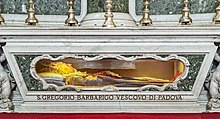Gregorio Barbarigo

Gregorio Barbarigo (born September 16, 1625 in Venice , † June 18, 1697 in Padua ) was a cardinal and is a saint of the Roman Catholic Church .
Life
Gregorio Barbarigo was the son of the future senator Gian Francesco Barbarigo and the Lugrezia Lion. He studied philosophy, law, mathematics, Greek and history at the University of Padua until he was called back home by his father in 1644.
Gregorio Barbarigo was Bishop of Bergamo from 1657 to 1664 . He began his ministry as Bishop of Bergamo, anything but natural at the time, with trips to the villages to visit the parishes. Pope Alexander VII elevated Bishop Barbarico to cardinal on April 5, 1660, whereupon he was installed as cardinal priest of San Tommaso in Parione in June 1660 . From 1664 to 1697 he was Bishop of Padua . Even during his lifetime he was venerated by people for his deep piety. Gregorio Barbarigo died in Padua on June 18, 1697.
canonization
Pope John XXIII revered Gregorio Barbarigo, who had been bishop of his home diocese, as an exemplary pastor and called him an example of “pastoral holiness”. He canonized him on May 26, 1960.
literature
- Friedrich Wilhelm Bautz : Barbarigo, Gregorio. In: Biographisch-Bibliographisches Kirchenlexikon (BBKL). Volume 1, Bautz, Hamm 1975. 2nd, unchanged edition Hamm 1990, ISBN 3-88309-013-1 , Sp. 365-366.
Web links
- Gregorio Barbarigo. In: Salvador Miranda : The Cardinals of the Holy Roman Church. ( Florida International University website, English)
Individual evidence
- ↑ Jared Wicks: Tridentine Motivations of Pope John XXIII before and during Vatican II . In: Theological Studies , vol. 75 (2014), pp. 847–862.
| predecessor | Office | successor |
|---|---|---|
| Giorgio Corner |
Bishop of Padua 1664–1697 |
Giorgio Cornaro |
| Luigi Grimani |
Bishop of Bergamo 1657–1664 |
Daniele Giustinian |
| personal data | |
|---|---|
| SURNAME | Barbarigo, Gregorio |
| BRIEF DESCRIPTION | Catholic cardinal and saint |
| DATE OF BIRTH | September 16, 1625 |
| PLACE OF BIRTH | Venice |
| DATE OF DEATH | June 18, 1697 |
| Place of death | Padua |

